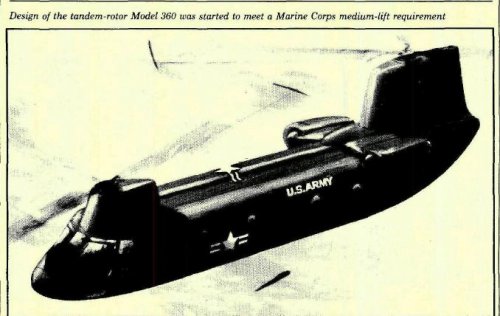- Joined
- 17 October 2006
- Messages
- 2,393
- Reaction score
- 1,191
I really ought to know more about this, but we seem to have a couple of people with some rotorcraft experience around these parts, but who knows what about the Boeing 360? It seems to have been discussed here only in passing.
Some stuff from Interavia, 1987...
Because of its origins, the 360 is very similar in size, inside and out, to the CH-46. However, its engines and transmission system are based on those of the much larger CH-47 - the powerplants are commercial AL5512s - so its ultimate lifting capacity is much greater than that of the CH-46. Although design gross weight is only 30,500lb (13835kg) at 3 g, sized to the HXM mission, tests will explore its performance at weights up to 46,000lb (20865kg)....
The 360 is designed to cruise smoothly and efficiently around 200kt (370km/h), compared with a typical maximum cruise speed of 160kt (300km/h) for current helicopters. The keys to this performance are reduced drag and advanced blade aerofoil sections...
An incidental benefit of a high-speed rotor blade, with its low stalling speed (essential because the airspeed of the retreating blade falls as the helicopter goes faster, not an obvious point to fixed-wing aviators), is that rotor RPM can be reduced at low-to-moderate forward speeds. At 90kt (167km/h), for example, this can significantly reduce noise, whether one is sneaking a special-operations team over enemy lines or using a city-centre heliport...
As it starts to demonstrate its performance, the 360 will make an interesting comparison to the V-22, particularly as the helicopter shares one of the tilt-rotor's baseline missions. At a constant empty weight, Boeing engineers conclude, the tilt-rotor has a longer range and higher speed, but the helicopter has a greater payload; the productivity of the two is roughly equal, but the tilt-rotor is better for long-range missions such as ASW or special operations, while the helicopter will be the best solution for a requirement such as ACA.
How much of this potential was ever realized? (Clearly some technology made its way into Comanche.) This paper:
http://endo.sandia.gov/AIAA_MDOTC/sponsored/Tarzanian.pdf
says it achieved 210 kt in level flight. And note that it was supposed to do the CH-46 replacement mission at a gross weight that's 3,000 pounds less than the empty weight of the V-22.
Some stuff from Interavia, 1987...
Because of its origins, the 360 is very similar in size, inside and out, to the CH-46. However, its engines and transmission system are based on those of the much larger CH-47 - the powerplants are commercial AL5512s - so its ultimate lifting capacity is much greater than that of the CH-46. Although design gross weight is only 30,500lb (13835kg) at 3 g, sized to the HXM mission, tests will explore its performance at weights up to 46,000lb (20865kg)....
The 360 is designed to cruise smoothly and efficiently around 200kt (370km/h), compared with a typical maximum cruise speed of 160kt (300km/h) for current helicopters. The keys to this performance are reduced drag and advanced blade aerofoil sections...
An incidental benefit of a high-speed rotor blade, with its low stalling speed (essential because the airspeed of the retreating blade falls as the helicopter goes faster, not an obvious point to fixed-wing aviators), is that rotor RPM can be reduced at low-to-moderate forward speeds. At 90kt (167km/h), for example, this can significantly reduce noise, whether one is sneaking a special-operations team over enemy lines or using a city-centre heliport...
As it starts to demonstrate its performance, the 360 will make an interesting comparison to the V-22, particularly as the helicopter shares one of the tilt-rotor's baseline missions. At a constant empty weight, Boeing engineers conclude, the tilt-rotor has a longer range and higher speed, but the helicopter has a greater payload; the productivity of the two is roughly equal, but the tilt-rotor is better for long-range missions such as ASW or special operations, while the helicopter will be the best solution for a requirement such as ACA.
How much of this potential was ever realized? (Clearly some technology made its way into Comanche.) This paper:
http://endo.sandia.gov/AIAA_MDOTC/sponsored/Tarzanian.pdf
says it achieved 210 kt in level flight. And note that it was supposed to do the CH-46 replacement mission at a gross weight that's 3,000 pounds less than the empty weight of the V-22.






